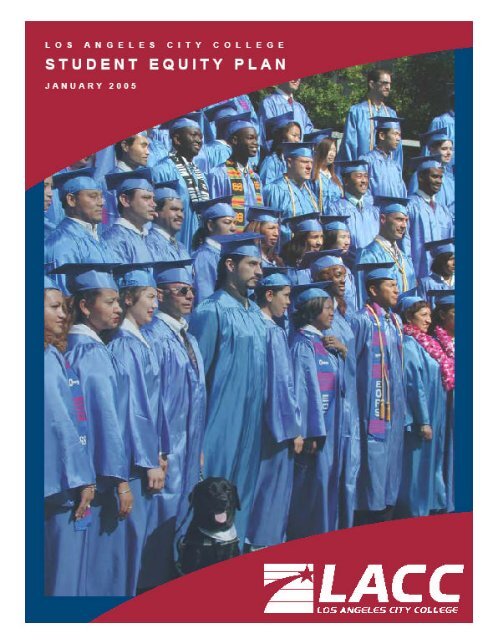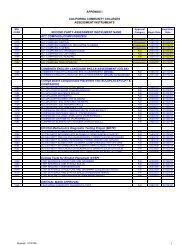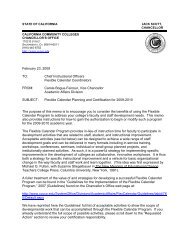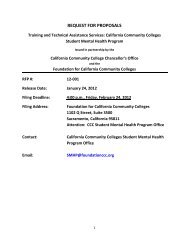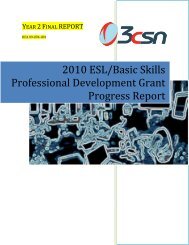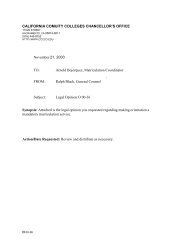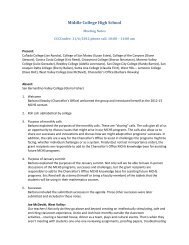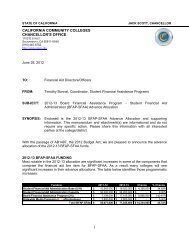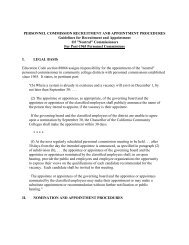Los Angeles City College
Los Angeles City College
Los Angeles City College
Create successful ePaper yourself
Turn your PDF publications into a flip-book with our unique Google optimized e-Paper software.
<strong>Los</strong> <strong>Angeles</strong> Community <strong>College</strong> District <strong>Los</strong> <strong>Angeles</strong> <strong>City</strong> <strong>College</strong><br />
Executive Summary<br />
2
Executive Summary<br />
California’s Master Plan for Higher Education, created in 1960, guarantees that all Californians,<br />
with a high school degree or equivalent, could access higher education by enrolling in<br />
the state’s community colleges. Community colleges have become the gate-keepers for the<br />
four-year colleges and universities, expected to produce qualified transfer-ready students as<br />
well as address the expanding need for basic skills and ESL education.<br />
The majority of the population served at <strong>Los</strong> <strong>Angeles</strong> <strong>City</strong> <strong>College</strong> faces financial, language<br />
and preparatory barriers. LACC represents a second chance for many students who arrive<br />
here ill-prepared to succeed in a traditional academic environment. The college is committed<br />
to providing the academic programs that students seek and the support services to assist them<br />
in achieving their educational goals. This plan seeks to identify the gaps in success rates<br />
among the populations served and address them.<br />
California Tomorrow, a non-profit research and advocacy organization, published California’s<br />
Gold: Claiming the Promise of Diversity in our Community <strong>College</strong>s in 2003. It cites the challenges<br />
facing our community colleges:<br />
• “a public policy climate in which the mission and survival of community colleges is threatened<br />
by insufficient attention, inadequate investment and lack of understanding of the role<br />
community colleges play in the lives of diverse communities and the state;<br />
• little accountability within the system for access, equity and diversity;<br />
• insufficient counseling and student supports, resulting in barriers to successful completion<br />
of education and aspirations;<br />
• few faculty and staff of color; insufficient training to help faculty and staff work effectively<br />
with a diverse student body;<br />
• heavy reliance on part-time faculty members who are not able to provide much extra time<br />
and support to immigrant students, students of color and first generation college-goers;<br />
• insufficient access to financial aid for a student population that often shoulders substantial<br />
family and work responsibilities;<br />
language barriers and a lack of understanding of immigrant students’ needs.”<br />
While identifying gaps and creating activities to minimize them, the Student Equity Plan cannot<br />
address all of the factors that contribute to student success. However, it is hoped that by calling<br />
attention to varying success rates, etc., we can help focus the college community’s attention<br />
on utilizing the many strengths of LACC to achieve improved outcomes for all of our students.<br />
This Student Equity Plan follows the procedures required by the State Chancellor’s Office. The<br />
populations are identified by ethnicity, gender and disability. It should be noted that another<br />
population worth identifying is immigrant status. These students often have special needs that<br />
must be addressed beyond looking at ESL success rates. The traditional assumption is that<br />
immigrant populations are within the Hispanic and Asian/Pacific Island groups. LACC serves a<br />
large Eastern European immigrant community that is included within the White ethnic designation.<br />
For the first indicator, two target groups were identified for achieving equity in access to the<br />
college. The Hispanic population in the community is 46% while enrollment of Hispanic students<br />
was at 41% of the college’s total student population (Fall 2003), down from a high of<br />
3
45% in 1999. The male enrollment at the college is 43%. While less than the 50% of the adult<br />
population identified as male, it is actually 1% higher than the national average of male community<br />
college students in 1997 (Phillippe and Patton, 2000, as cited in California’s Gold).<br />
LACC’s male student population is higher in comparison with the other eight colleges within<br />
the <strong>Los</strong> <strong>Angeles</strong> Community District. While the gaps are not remarkable, the college has decided<br />
to establish goals and activities to increase the enrollment of both populations.<br />
There are two basic thrusts of the activities to increase enrollment for both Hispanic and male<br />
students. The Office of Institutional Effectiveness will research factors and influences that may<br />
be causing these groups not to enroll in community college and target marketing to these<br />
populations. They will also identify population trends within the community we serve. In addition,<br />
for the Hispanic group, the college will expand its bi-lingual activities to reach and serve<br />
Spanish speaking students for whom language is a barrier.<br />
A third group, the disabled students, also shows a gap in access. Members of the Student Equity<br />
Committee see that gap as one that exists within the college community. It is believed that<br />
many disabled students are enrolled at the college but are unaffiliated with the Office of Special<br />
Services (formerly DSPS). Therefore the activities to address this gap are directed to the<br />
current student population rather than out into the community.<br />
In the second area, the data on course completion rates indicates an appreciable gap in the<br />
success rates of both Hispanic and Black students, as compared to the White students. Several<br />
existing early intervention activities will be assessed for their effectiveness, and restructured<br />
and/or expanded as warranted. In an effort to institutionalize the on-going review of success<br />
among our diverse student populations, the Equity Plan calls for including ethnic data,<br />
and its analysis, in both academic and student services program review.<br />
The academic departments’ program reviews acknowledged the need to provide academic<br />
support for students’ success. The Equity Plan includes expansion of tutoring and access to<br />
instructional labs, such as the Math Pi Shop (see Attachment section) and the English Writing<br />
Lab. One very successful program, supplemental instruction, has demonstrated its positive<br />
effect on student outcomes, and one activity is to expand it. Data on the success of this activity<br />
is included in the Attachments section.<br />
The third aspect of student equity, ESL and Basic Skills completion, examines the success of<br />
students, by each group, who complete a degree applicable course after having completed the<br />
final ESL or basic skills course, within a two year time frame. As noted in California’s Gold,<br />
“students who took the basic skills/remedial coursework were slightly more likely to earn degrees<br />
and certificates, though it took them longer to do so. However, these students were less<br />
likely to transfer.” Further study is indicated on the goals of the students completing the ESL<br />
program to determine whether that was an end in itself, and, if that is the case, revising the<br />
method of evaluating this area.<br />
The data for the fourth student success indicator, degrees and certificate completion, indicated<br />
a gender based gap. A disproportionate number of female students are attaining degrees and<br />
certificates compared to the male population. The college needs to collect data on how the<br />
two populations compare in their educational goals and courses of study, and then analyze<br />
that data for its affect on awarding of degrees and certificates. With the data in hand, the college<br />
can detail activities to address any gaps that may exist. Prior data is included in the Attachments<br />
section; however, the Committee is requesting further delineation within the data.<br />
4
The last aspect to be addressed as a student success indicator is transfer. Using the college’s<br />
metric for this indicator, the Student Equity Committee found no disparity among the identified<br />
groups. Promoting transfer among all of LACC’s students is an on-going goal of the college. Additional<br />
data collected on transfer is included in the Attachments section.<br />
To support the activities of the Student Equity Plan, the college will be using Program 100 funds,<br />
as well as additional support from several categorical programs: Matriculation, BFAP (Financial<br />
Aid), and EOP & S, within their allowable expenditure, and the Title V grant, within its objectives.<br />
Contact person: Leanna Watts, Dean, Student Services (323) 953-4000, ext. 2450<br />
855 North Vermont Avenue <strong>Los</strong> <strong>Angeles</strong> CA 90029<br />
Email: wattslf@lacitycollege.edu<br />
5


